Coronavirus (COVID-19): modelling the epidemic (issue no. 35)
Latest findings in modelling the COVID-19 epidemic in Scotland, both in terms of the spread of the disease through the population (epidemiological modelling) and of the demands it will place on the system, for example in terms of health care requirement
Coronavirus (COVID-19): modelling the epidemic in Scotland (Issue No. 35)
Background
This is a report on the Scottish Government modelling of the spread and level of Covid-19. This updates the previous publication on modelling of Covid-19 in Scotland published on 14 January 2021. The estimates in this document help the Scottish Government, the health service and the wider public sector plan and put in place what is needed to keep us safe and treat people who have the virus.
This edition of the research findings focuses on the epidemic as a whole, looking at estimates of R, growth rate and incidence as well as local measures of change in the epidemic.
Key Points
- The reproduction rate R in Scotland is currently estimated as being between 0.8 and 1.1. This is a decrease compared to last week.
- The number of new daily infections for Scotland is estimated as being between 54 and 194, per 100,000 people.
- The growth rate for Scotland is estimated as being between -4% and 1%.
- The proportion of people testing positive who had no clinical risk groups has risen from around 55% in November to just over 60% in mid-January.
- Average contacts have decreased by approximately 31% in the last two weeks bringing them lower than the level of contacts per person for the UK as a whole at the beginning of the first lockdown in March. There have been further reductions in mean contacts associated with work and, to a lesser extent, home, by 27% and 16% respectively in the last two weeks. There have been significant reductions in mean contacts within the other setting, reducing by 52%.
- The proportion of participants visiting non-essential shops has decreased significantly from 31% to 6% in the last two weeks and those visiting another's home has reduced from 41% to 25%.
- Modelled rates per 100K indicate that by the week of 31 January - 6 February 2021, 25 (down 5 from last week) local authorities have at least a 75% probability of exceeding 50 cases, 12 (down 17) of those have at least a 75% probability of exceeding 100 cases, 0 (down 22) of those have at least a 75% probability of exceeding 300 cases and 0 (down 13) have at least a 75% probability of exceeding 500 cases. This is an improvement compared to the position last week. The probability of exceeding will be effected by the latest lockdown as well as by how much new variant is present in a local authority area. This adds to the uncertainty around this modelling this week.
- Analysis of levels of Covid in wastewater shows a similar national pattern to the rise in new cases experienced recently. In the last two weeks there has been a stabilisation or decrease.
Overview of Scottish Government Modelling
Epidemiology is the study of how diseases spread within populations. One way we do this is using our best understanding of the way the infection is passed on and how it affects people who catch it to create mathematical simulations. Because people who catch Covid-19 have a relatively long period in which they can pass it on to others before they begin to have symptoms, and the majority of people infected with the virus will experience mild symptoms, this "epidemiological modelling" provides insights into the epidemic that cannot easily be measured through testing e.g. of those with symptoms, as it estimates the total number of new daily infections and infectious people, including those who are asymptomatic or have mild symptoms.
Modelling also allows us to make short-term forecasts of what may happen with a degree of uncertainty. These can be used in health care and other planning. The modelling in this research findings is undertaken using different types of data which going forward aims to both model the progress of the epidemic in Scotland and provide early indications of where any changes are taking place.
Modelling outputs are provided here on the current epidemic in Scotland as a whole, based on a range of methods. Because it takes a little over three weeks on average for a person who catches Covid-19 to show symptoms, become sick, and either die or recover, there is a time lag in what our model can tell us about any re-emergence of the epidemic and where in Scotland this might occur. However modelling of Covid deaths is an important measure of where Scotland lies in its epidemic as a whole. In addition, the modelling groups which feed into the SAGE consensus use a range of other data along with deaths in their estimates of R and the growth rate. These outputs are provided in this research findings. The type of data used in each model to estimate R is highlighted in Figure 1.
A medium term projection of the number of cases, ICU and hospital bed demand is also provided at this stage of the epidemic in Scotland.
An update of results are provided from the Scottish Contact Survey (SCS), to indicate how people's contacts have changed over the last two weeks.
It should be noted that this research findings covers a period of uncertainty with the growth of the new variant in Scotland (SARS-CoV-2 VUI 202012/01). The percentage of cases composed of this new variant is increasing in Scotland, from 62% in the 24 hour reporting period from 10 to 11 January to 64% from 17 to 18 January 2021 [1]. The rate of increase of the percentage of the new variant has slowed in the last week.
What the modelling tells us about the epidemic as a whole
The various groups which report to the Scientific Pandemic Influenza Group on Modelling (SPI-M) use different sources of data in their models (i.e. deaths, hospital admissions, cases) so their estimates of R are also based on these different methods. SAGE's consensus view across these methods, as of 20 January, was that the value of R in Scotland was between 0.8 and 1.1 (see Figure 1). The value of R on 13 January was between 1.0 and 1.4.
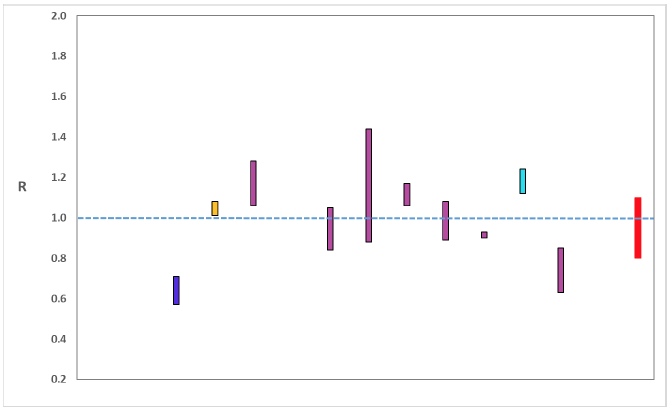
Source: Scientific Advisory Group for Emergencies (SAGE).
The various groups which report to the Scientific Pandemic Influenza Group on Modelling (SPI-M) use different sources of data in their models to produce estimates of incidence (Figure 2). SPI-M's consensus view across these methods, as of 20 January, was that the incidence of new daily infections in Scotland was between 54 and 194 new infections per 100,000. This equates to between 3,000 and 10,600 people becoming infected each day in Scotland.
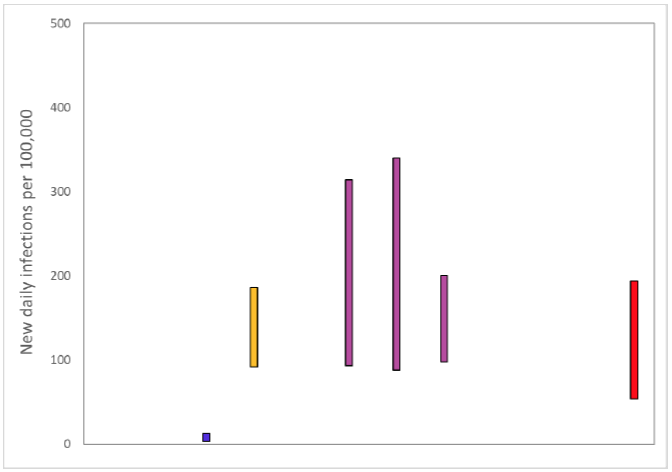
Source: Scientific Pandemic Influenza Group on Modelling (SPI-M).
The consensus from SAGE for this week is that the growth rate in Scotland is between -4 and 1% per day. On 13 January the growth rate was between 0% and 6%.
The logistical model developed by Scottish Government to assess implications for health care demand (see previous Research Findings) has been adapted to produce a medium-term prediction of infections.
Figure 3 shows two projections which take account of vaccine roll-out (better and worse).
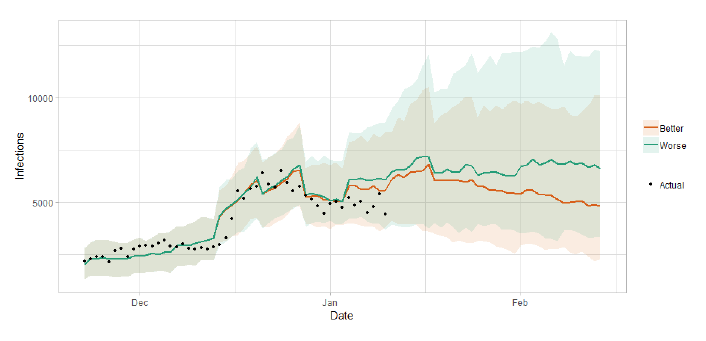
What the modelling tells us about Hospital bed and ICU bed demand
Figure 4 shows the impact of the projections on the number of people in hospital.
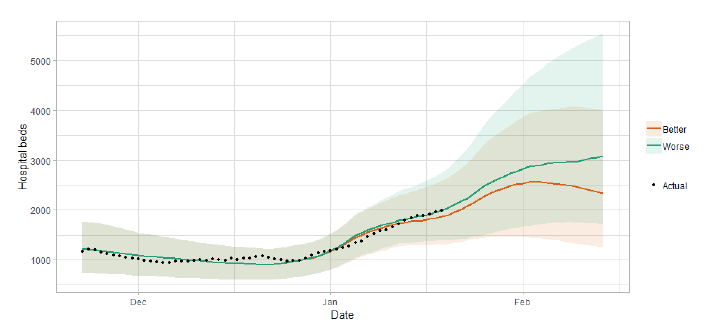
Figure 5 shows the impact of the projection on ICU bed demand.
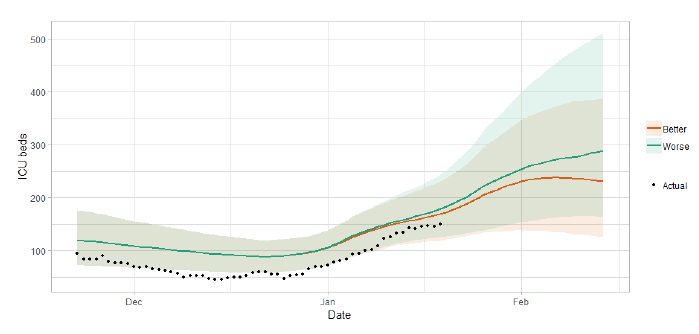
What the modelling tells us about projections of hospitalisations in the medium term
SAGE produce projections of the epidemic [3] (Figure 6), combining estimates from several independent models (including the Scottish Government's logistics modelling, as shown in figures 3, 4 and 5). These projections are not forecasts or predictions. They represent a scenario in which the trajectory of the epidemic continues to follow the trends that were seen in the data up to 18 January and do not account for the impact of future policy or behaviour changes.
They will not fully reflect the impact of policy changes made in the two to three weeks prior to 18 January, such as the national restrictions announced on 4 January. Nor do they include seasonal effects that might increase transmission.
The projections are based on the trends in the available epidemiological data and will only include the impact of vaccinations where this has influenced these trends.
The projections do not include the impact of vaccinations which have yet to be administered or any possible expansion of the programme over the coming weeks. They will include the effect of any benefits of vaccination seen to date. The delay between vaccination, the build-up of immunity and infection means the impact on admissions and deaths over the next 4 weeks is expected to be limited.
Beyond two weeks, the projections become more uncertain with greater variability between individual models. This reflects the large differences that can result from fitting models to different data streams, and the influence of small deviations in estimated growth rates and current incidence.
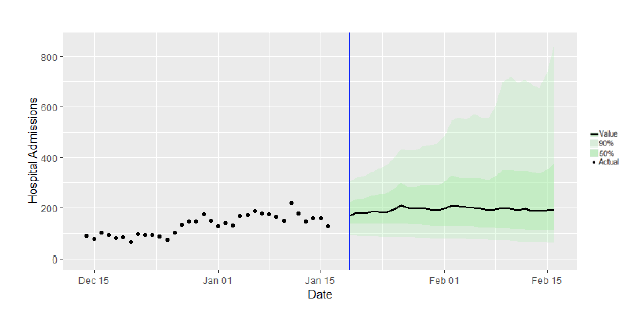
What we know about who is testing positive with Covid
The Early Pandemic Evaluation and Enhanced Surveillance of COVID-19 (EAVE) 2 Study Group [4] have updated the pattern of demographics and clinical risk groups over time for those who tested positive.
The proportion of young adults aged 18-39 testing positive peaked at the beginning of September before reducing a little (reaching around 35% around the end of November) then increasing to around 40% in mid-January (Figure 7). About 15% of people now testing positive are 65 or over.
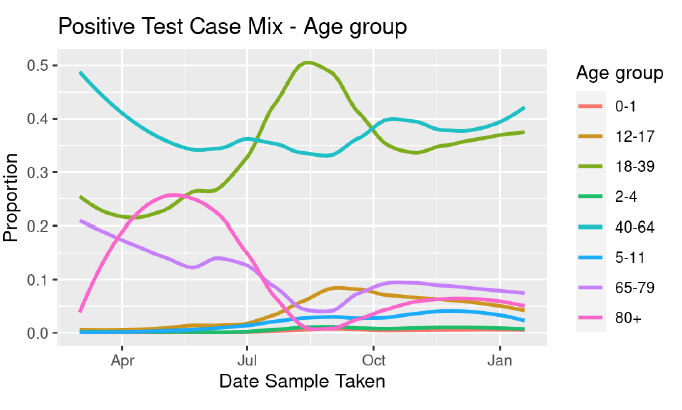
The proportion of people testing positive who had no clinical risk groups has risen from around 55% in November to just over 60% in mid-January (Figure 8). The proportions testing positive with three or more risk groups appears to have reduced slightly since mid-November.
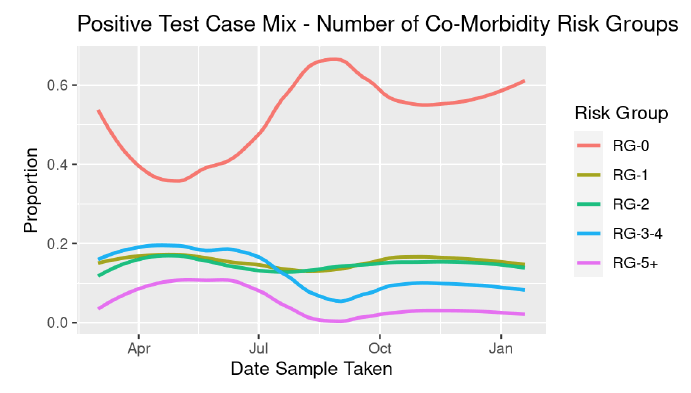
What we know about how people's contact patterns have changed
Since the survey that covered the period of festive bubble, 24 – 30 December, mean contacts have reduced from 3.6 to 2.5 as shown in Figure 9. The current level of contacts is now lower than observed contacts per person for the UK as a whole at the beginning of the first stay-at-home advice in March (2.8 from POLYMOD [5]).
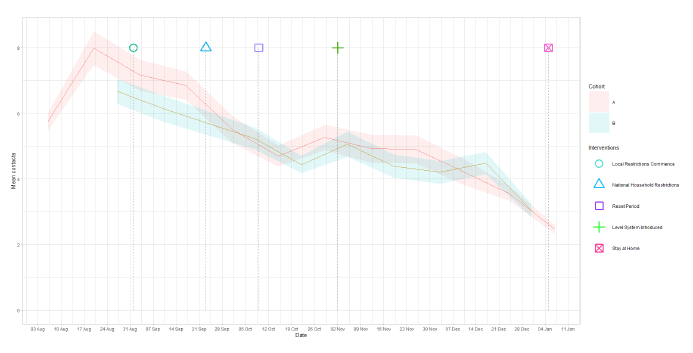
Figure 10 shows the average (mean) contacts in all settings.
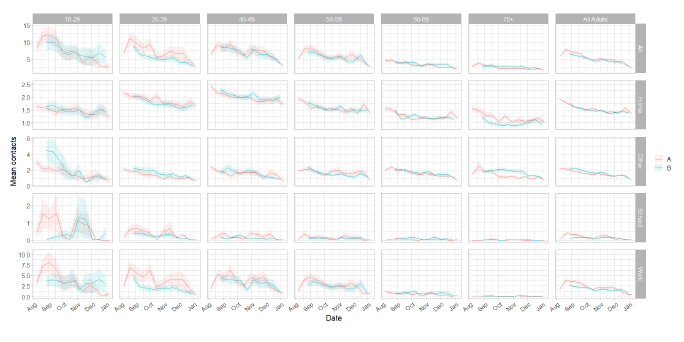
Overall, the biggest reduction in mean contacts is seen within the other setting. This has reduced by 52% for the most recent survey (7– 13 January) compared to the festive period two weeks prior (24 – 30 December) as seen in Figure 11. Mean contacts within the work (Figure 12) and home setting have also decreased by 27% and 16% respectively.
Although overall there have been decreases across the majority of settings, there have been some increases within age groups within these settings over the same period. The 18-29 age group is approximately 6 times higher within the work setting and the 60-69 age group is approximately 4 times higher in this setting. These conflicting contact responses around the workplace are likely due to key workers returning to work after the festive period as well as individuals who cannot work from home combined with the impact of the new lockdown driving the reduction in contacts in others.
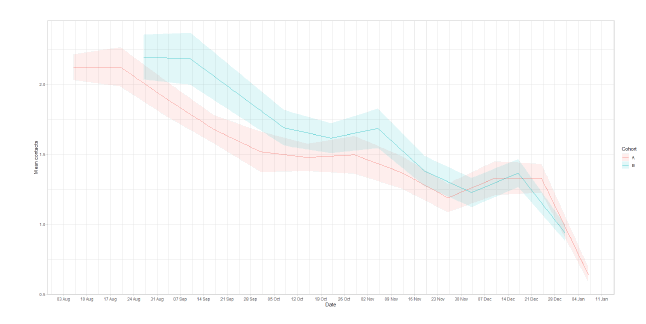
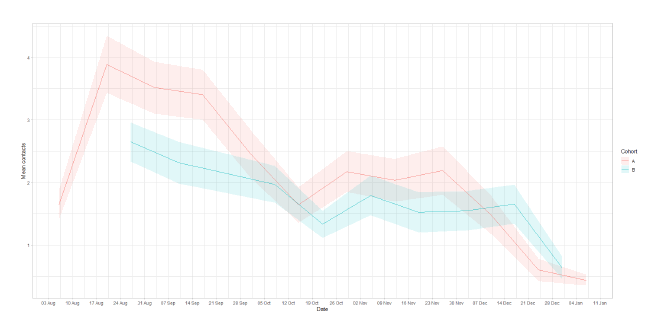
The heatmaps in Figure 13 show mean contacts between age groups before (10 – 16 December), during (24 – 30 December) and after the festive period (7 – 13 January). This illustrates a widespread decrease in contacts since the lead up to the festive period, particularly with interactions between the younger age groups and those aged between 30 and 60.
Breaking this down further (Figure 14), looking specifically at mean contacts in the home, the smaller decrease in contacts observed comparatively to what can be seen overall is clearly shown. For example, despite the 30-39 age group decreasing their overall contacts, they have had increases with specific age groups within the home setting.
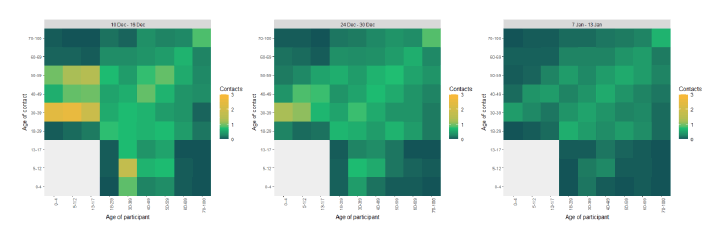
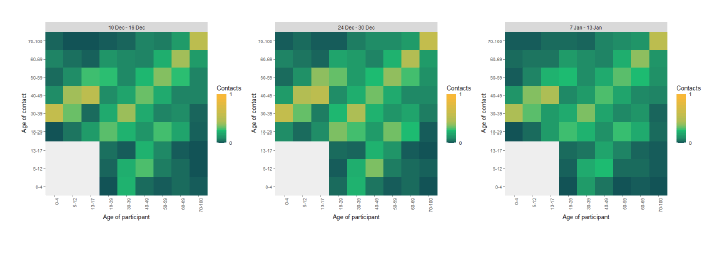
As Figure 15 shows, there have been significant decreases in participants visiting all settings in comparison to the level two weeks prior. The biggest decrease in participant behaviour over the last two weeks has been visits to non-essential shops, dropping from 31% (24 – 30 December) to 6% (7 – 13 January). The percentage of participants visiting another home has also decreased from 41% to 25% over the same period.
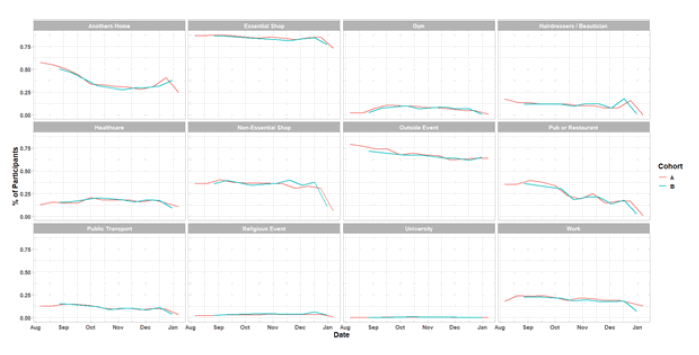
What we know about which local authorities are likely to experience high levels of Covid
We use modelling based on Covid cases and deaths [6], conducted by Imperial College London, to give us an indication of whether a local authority is likely to experience high levels of Covid in the future. An area is defined as a hotspot if the two week prediction of cases (positive tests) per 100K population are predicted to exceed a threshold, e.g. 500 cases. See technical annex in issue 24.
Modelled rates per 100K (Figure 16) indicate that by the week of 31 January - 6 February 2021, 25 (down 5 from last week) local authorities have at least a 75% probability of exceeding 50 cases, 12 (down 17) of those have at least a 75% probability of exceeding 100 cases, 0 (down 22) of those have at least a 75% probability of exceeding 300 cases and 0 (down 13) have at least a 75% probability of exceeding 500 cases. The probability of exceeding will be affected by the lockdown as well as by how much new variant is present in a local authority area. This adds to the uncertainty around this modelling this week.
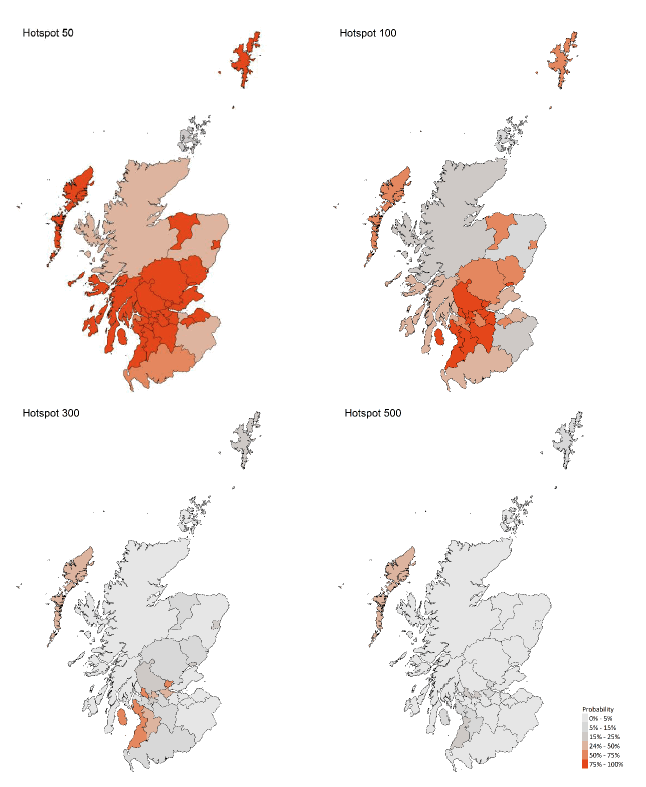
What can analysis of wastewater samples tell us about local outbreaks of Covid-19 infection?
Levels of Covid in wastewater collected at 28 sites around Scotland are adjusted for population and local changes in intake flow rate and compared to daily 7-day average positive case rates derived from Local Authority and Neighbourhood (Intermediate Zone) level aggregate data. See Technical Annex in Issue 34 of these Research Findings for the methodology.
Analysis of levels of Covid in wastewater [8] shows a similar national pattern to the rise in new cases experienced recently. There was a rapid increase in Covid in the time around Christmas and the New Year, and subsequently a stabilisation or decrease (Figure 17).
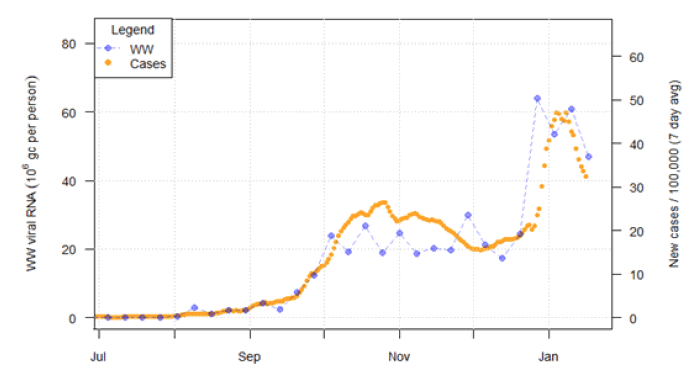
The geographic pattern of Covid across the sites may also be shown. Here 2-week aggregate means are taken for both the wastewater Covid data and the corresponding neighbourhood level case data, and plotted as a map (Figure 18), with the sizes of the circles denoting the local level of viral Covid RNA (in gc/person [9]) or the rate of new cases. Crosses denote sites with no observations during that period.
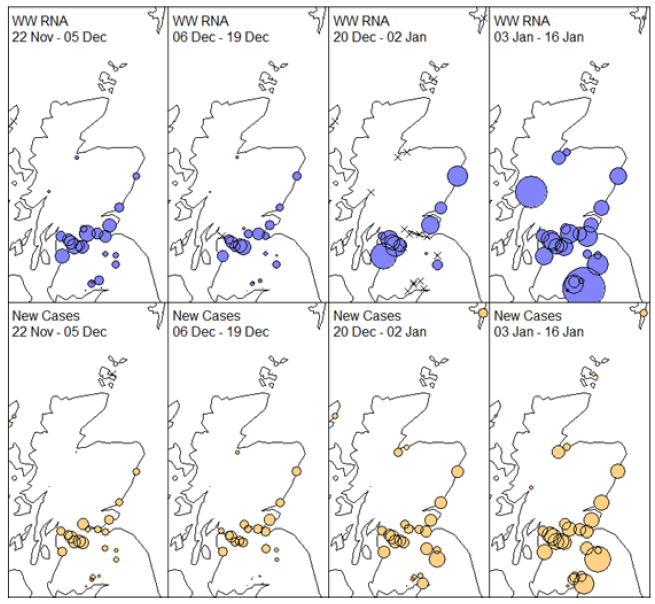
Over this period, the patterns of Covid across sites are similar in both the level of Covid in wastewater (blue) and new cases (orange). Two clear exceptions are Fort William in the North West, and Annan in the South East of the map which both show much higher recent level of Covid in wastewater than would be expected from the case data and local population. This may be due to specific aspects of those sites, but it should be noted that both represent relatively small populations of approximately 8,000.
Some specific sites, at Nigg (Aberdeen City) (Figure 19) and Seafield (City of Edinburgh) (Figure 20) show clear examples of large increases in cases in late December/early January that have subsequently reduced. In general, it has been noted that the levels of Covid in wastewater in million gc/person approximately match to new cases/100k. However, during this recent period, the spike in levels of Covid in wastewater has exceeded the degree of increase in cases, implying higher relative changes in wastewater Covid than new cases. We see a similar picture at several other sites.
This may be partially accounted for by smoothing of case numbers due to the 7 day averaging methodology, or to the influence of particular weather conditions on the sewage measurements. This apparent effect will be investigated further.
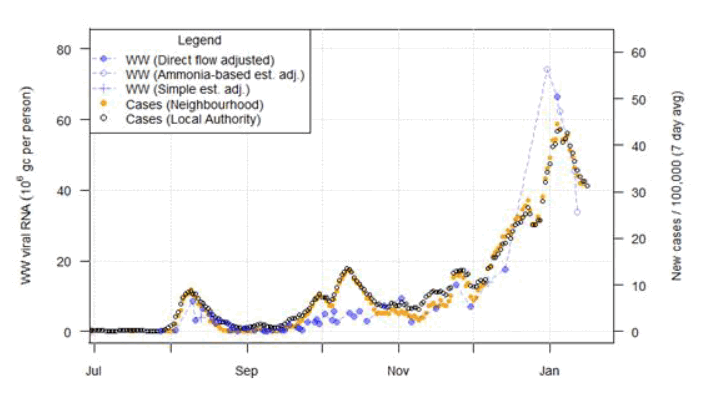
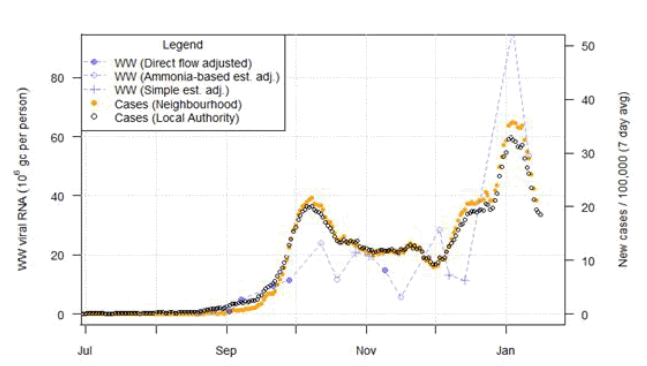
What next?
The Scottish Government continues to work with a number of academic modelling groups to develop other estimates of the epidemic in Scotland.
The modelled estimates of the numbers of new cases and infectious people will continue to be provided as measures of the epidemic as a whole, along with measures of the current point in the epidemic such as Rt and the growth rate. Further information can be found at https://www.gov.scot/coronavirus-covid-19.
Investigations are ongoing by NERVTAG, SPI-M, SAGE and Scottish Government regarding the impact of the new variant, SARS-CoV-2 VUI 202012/01, which will be reflected here as work is undertaken.
Contact
There is a problem
Thanks for your feedback